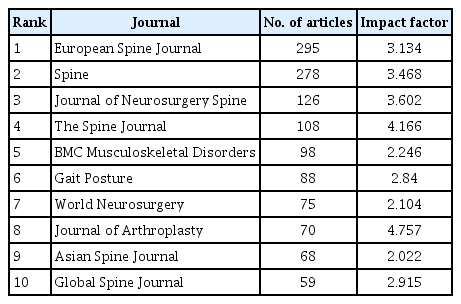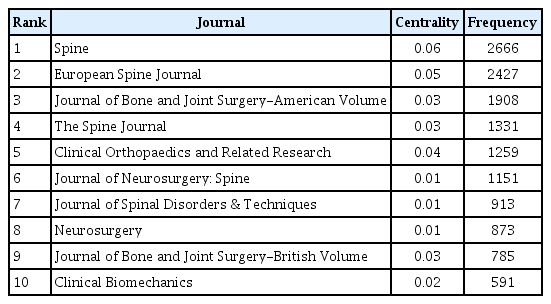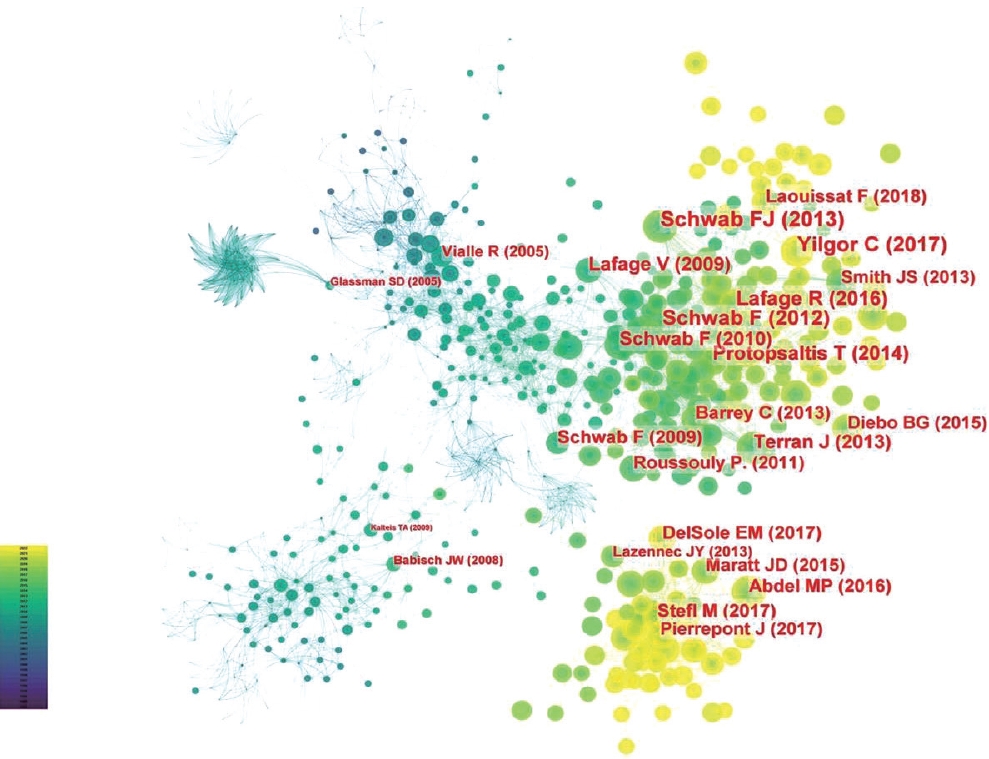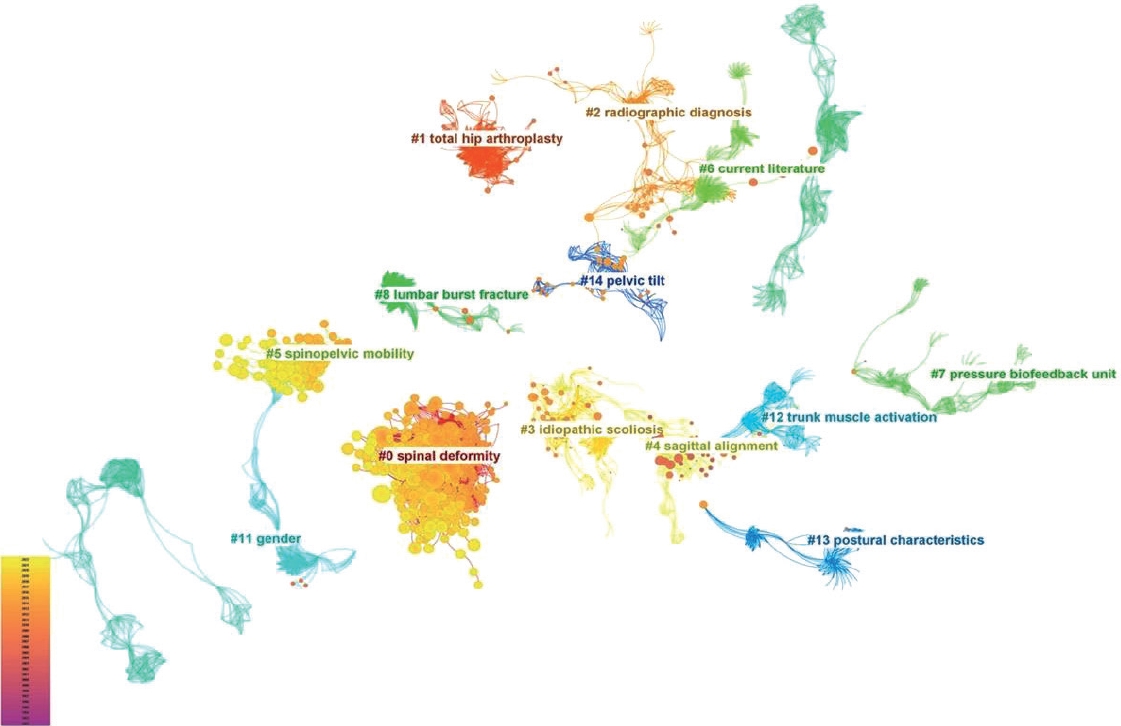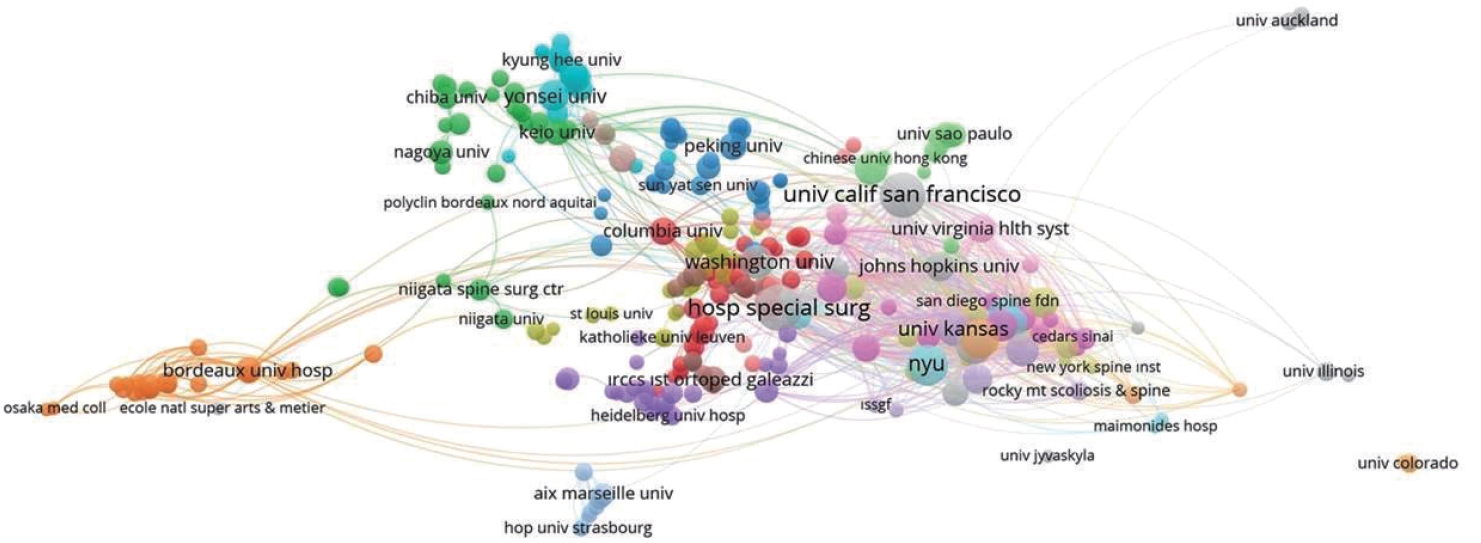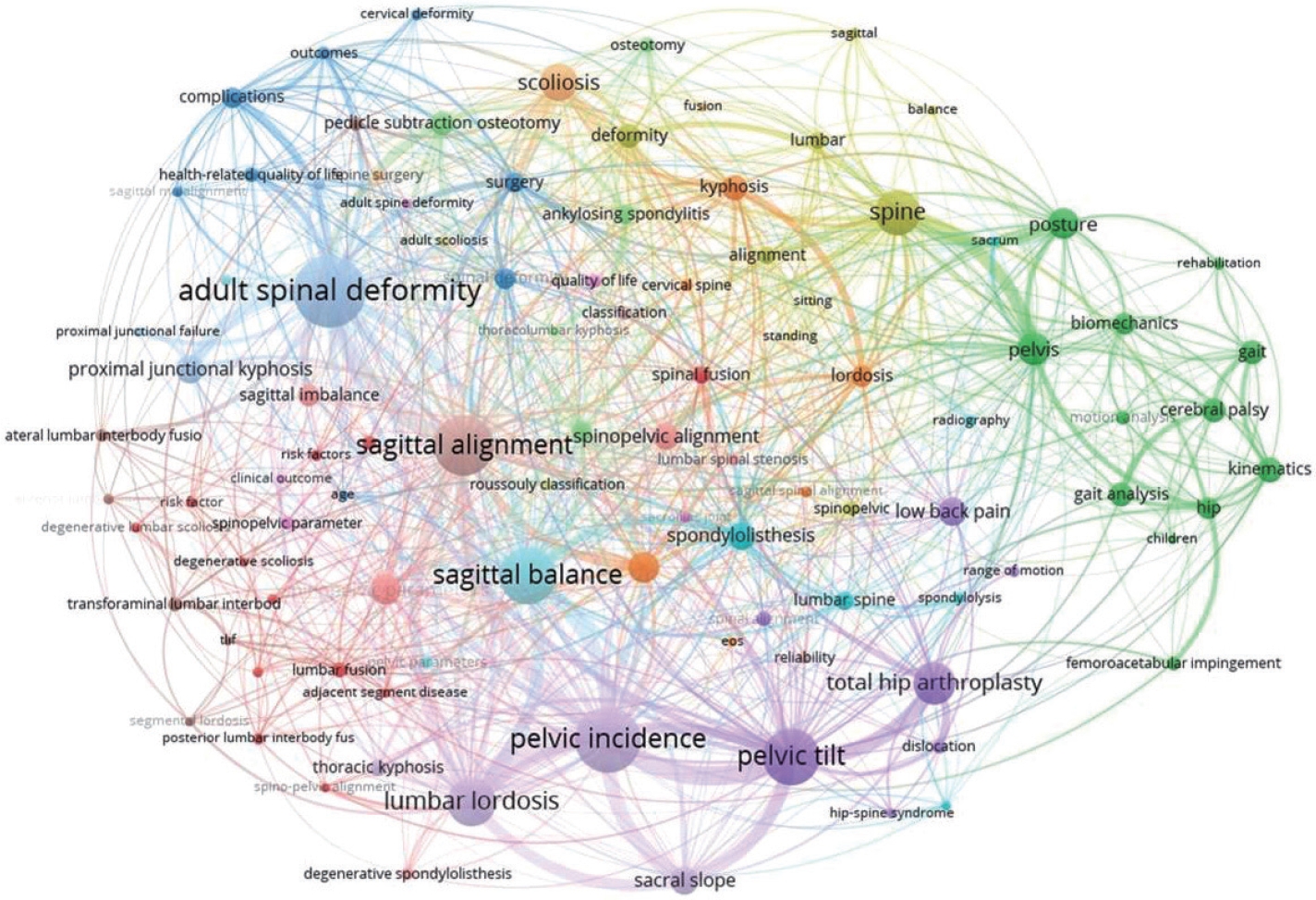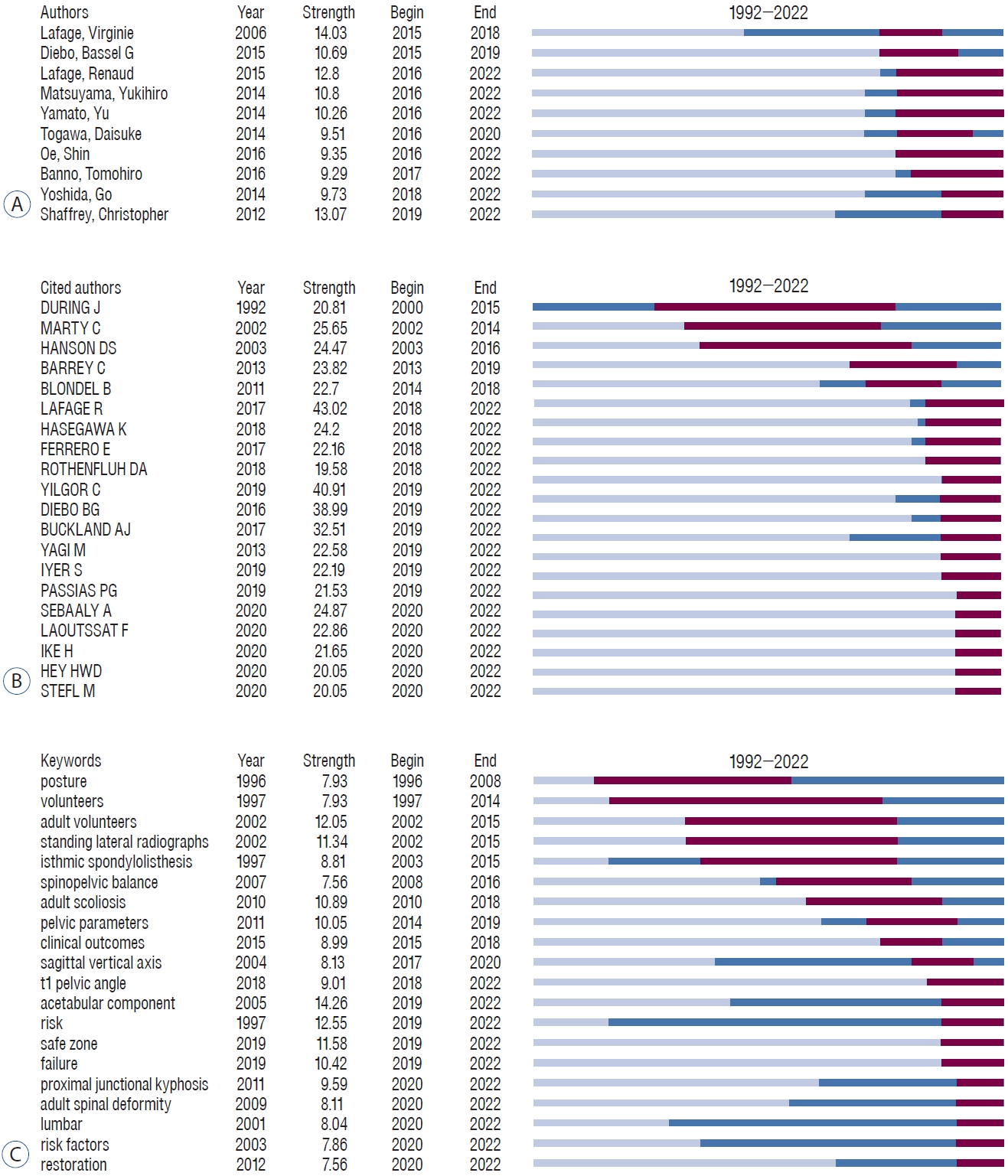Publication Trends in the Pelvic Parameter Related Literature between 1992 and 2022 : A Bibliometric Review
Article information
Abstract
Objective
This study aimed to conduct a bibliometric analysis on pelvic parameter related research over the last 30 years, analyzing trends, hotspots, and influential works within this field.
Methods
A comprehensive Web of Science database search was performed. The search yielded 3249 results, focusing on articles and reviews published from 1992 to 2022 in English. Data was analyzed using CiteSpace and VOSviewer for keyword, authorship, and citation burst analysis, co-citation analysis, and clustering.
Results
The number of publications and citations related to pelvic parameters has increased exponentially over the last 30 years. The USA leads in publication count with 1003 articles. Top publishing journals include the European Spine Journal, Spine, and Journal of Neurosurgery: Spine, with significant contributions by Schwab, Lafage V, and Protoptaltis. The most influential articles were identified using centrality and sigma values, indicating their role as key articles within the field. Research hotspots included spinal deformity, total hip arthroplasty, and sagittal alignment.
Conclusion
Interest in pelvic parameter related research has grown significantly over the last three decades, indicating its relevance in modern orthopedics. The most influential works within this field have contributed to our understanding of spinal deformity, pelvic incidence, and their relation to total hip arthroplasty. This study provides a comprehensive overview of the trends and influential research in the field of pelvic parameters.
INTRODUCTION
The pelvis constitutes the load transferring unit between the trunk and the lower extremities. Its shape and position in the space is a result of the upright position of the humans [1]. The load from the trunk passes on to the pelvis at the sacral plateau, and the load from pelvis to the lower extremities passes on the lower extremities through the femoral heads. Deformities or malalignment in either sagittal or coronal plane are associated with disability and pain [4,7]. There has been considerable literature on the optimal way to assess spinopelvic alignment in the recent decades. Pelvic tilt, pelvic incidence, sacral slope, sagittal vertical axis (SVA) are some of the more commonly used parameters [5]. There is no consensus on the best parameters for evaluation or pre-op planning adult spinal deformity, and the evolution of the literature reflects this [9,19].
Bibliometric analysis is a method of evaluating the network of countries, institutions, journals, and researchers, identifying popular topics (“hot spots”) and predicting the research trends. To our knowledge, there are no currently no bibliometric studies on pelvic parameter related research. This study aims to visualize the landscape in the literature and both qualitatively and quantitatively assess trends and hot spots in the last 30 years.
MATERIALS AND METHODS
The Institutional Review Board of Istanbul Physical Treatment and Rehabilitation Training and Research Hospital approval was obtained (02/2023:001). Informed consent was not obtained for this study as only publicly available information was used. The search utilizing every form of the term related to various pelvic parameters was conducted in the Web of Science (WoS) database as follows : (TS = ((“pelvic parameter”) OR (“spinopelvic parameter”) OR (“pelvic tilt”) OR (“sacral slope”) OR (“pelvic incidence”))), and document type was set as “Articles”, and indexes were set as “SCI-EXPANDED”. Document type was narrowed to include only include articles and reviews. Results were narrowed down to include publications from 1992 to 2022 in English language. Three thousand two hundred forty-nine results were obtained. Titles, authors, abstracts, institutions, countries, journals, references, and the citation information were recorded.
The obtained data from WoS was imported to CiteSpace 6.1.R6, 64-Bit (Drexel University, Philadelphia, PA, USA) [2] and VOSviewer 1.6.15 [20]. Keyword, authorship and citation burst analysis was performed. Network of keywords and organizations were analyzed with VOSviewer. Co-citation analysis and clustering was performed with CiteSpace.
In the context of our study, we utilize centrality and sigma values, Silhouette, and different labeling methods (latent semantic indexing [LSI], log-likelihood ratio [LLR], mutual information [MI]) as tools in our bibliometric analysis. They help us identify key articles, evaluate the quality of clustering, and understand the content and characteristics of each cluster, respectively.
RESULTS
The study established a network of 33498 references cited by 3249 nodes. The number of publications increased from three in 1992 to 443 in 2022, and the number of citations rose from one in 1992 to 9989 in 2022. Both of these metrics are highly correlated and are increasing exponentially (Fig. 1). Over the 30-year period analyzed, 88% of studies were published in the last decade, and 57% of the studies were published within the last 5 years. The citations generated in 2022 alone exceeded the total number of citations from 1992 to 2013 (9989 vs. 8660).
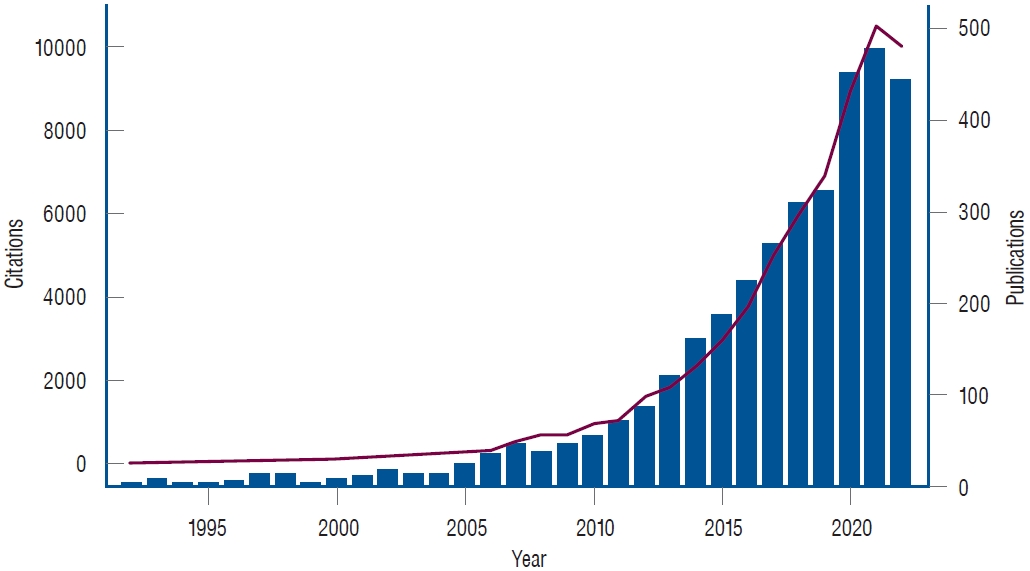
Number of publications and citations generated per year. Red line represents the number of citations.
Country analysis
Table 1 summarizes the top ten countries with the highest number of publications. The USA leads with 1003 articles and a centrality of 0.64. Burst analysis (Fig. 2) reveals that South Korea, Italy, and Turkey experienced a surge in publications at the beginning of the last decade.
Journal analysis
The top 10 journals publishing the majority of articles are also summarized in Table 2. Sixty percent of these journals are based in the USA, accounting for 75% of the publications in the top 10 list. The most co-cited journal, “Spine”, holds the top position with a frequency of 2666 citations and a centrality value of 0.06, indicating its significant influence within the field since 1992 (Table 3).
Co-citation and co-cited reference cluster analysis
Co-citation analysis was performed, with lighter colors in Fig. 3 indicating more recent publications. Each node represents a cited article, with the node’s diameter proportional to its co-citation count. The top 10 co-cited articles on pelvic parameter-related research are shown in Table 4. Fig. 4 shows the clustering of co-citations according to title, abstract, and keywords, with only connected clusters visualized. Top 10 clusters ranked according to size are shown in Table 5. Supplementary Table 1 provides a ranking of the top 10 publications based on their Sigma value, indicating their significance in the research area of spinal alignment and related conditions.
Supplementary Table 2 lists the top 10 publications ranked by centrality, highlighting their importance in the network of spinal research based on the frequency of their citation and reference. Supplementary Table 3 identifies the major citing articles for each cluster, showing the most influential papers that have significantly cited the research in each specific cluster of spinal study.
Organization and keyword analysis
Network visualization of the organizations was performed with VOSviewer. Of 3206, 342 met the minimum threshold of five publications (Fig. 5). Larger text indicates a more significant contribution and color indicates the cluster of more strongly connected organizations. Network visualization was also performed for the 100 most commonly used keywords (Fig. 6), with larger link widths indicating stronger connections.
Burst analysis
Burst analysis was performed for authorship, times cited, and keywords. Fig. 7 shows the top 10 authors with spikes in authored publications, the top 20 authors with spikes in times cited, and the change in popular keywords over the last 30 years, respectively. Some of the popular keywords are non-specific, such as ‘risk factors’ or ‘restoration’, but specific keywords related to measurements (e.g., T1 pelvic angle and SVA) and proximal junctional kyphosis have gained popularity in recent years.
DISCUSSION
Centrality is a key metric in network analysis, reflecting the importance of an article within its cluster. In this context, it refers to how well an article connects to other articles in the same cluster. An article with a higher centrality is considered to be more influential than others. Sigma values, on the other hand, indicate an article’s significance based on its citation patterns. A higher sigma value suggests that an article is more frequently cited than expected, implying its substantial influence in the field. Together, centrality and sigma values assist in identifying key articles within clusters. They highlight articles that not only connect numerous other pieces but also receive more citations than anticipated, signifying their prominence. Silhouette values represent the quality of clustering. Labels using different techniques (LSI, LLR, MI) were used for assigning descriptive names to clusters.
Pelvic morphology and its position relative to the trunk and lower extremities are popular topics in orthopedics as it affects gait mechanics. The normal coronal alignment of pelvis is symmetric and horizontal. The sagittal alignment is more complex [8]. The ideal sagittal balance is present when body weight is positioned along a line slightly behind the axis of rotation of the femoral heads [15,17]. Several angles and lines are classicaly used to assess the sagittal alignment. Pelvic incidence, pelvic tilt and sacral slope are the sagittal parameters of the pelvis. Pelvic incidence is a radiographic measurement that refers to the angle between the line perpendicular to the sacral plate and the line connecting the midpoint of the sacral plate to the center of the femoral heads. Sacral slope refers to the angle formed between the horizontal plane and the superior surface of the sacrum. It is an important parameter used to evaluate the alignment of the pelvis and spine in radiographic images. Lower pelvic incidence is associated with a smaller sacral slope and vice versa [7]. Pelvic incidence is also related with the lumbar lordosis as required degree of lumbar lordosis is roughly 10 degrees more than the pelvic incidence in the surgical setting [10,18]. Pelvic tilt is also an important parameter indicative of pelvic compensation and increased pelvic tilt is associated with increased disability [6].
Not only sagittal balance deviates in patients with adult spinal deformity compared to normal population, various spinal pathologies affect the sagittal balance in different ways [12]. Recent studies suggest that sagittal spinal alignment is more important than coronal deformity when correlated with significant disability [3,13]. Using bibliometric analysis, our data also revealed research related to sagittal balance and pelvic parameters achieved significant growth over the last decade.
This study also showed the popular authors, keywords and references in the literature both qualitatively and quantitatively. Keyword burst analysis is a feature of CiteSpace that allows searching for popular keywords within titles, abstracts or reference titles in the dataset. Some of the popular keywords are non-specific such as “risk factors” and do not offer any particular insights. Others; however, are more specific and can suggest the popular themes in the literature. In our case, three specific keywords that are popular recently stand out : SVA, T1 pelvic angle, and proximal junctional kyphosis.
SVA is a measurement used in spinal evaluation that determines the vertical alignment of the head, trunk, and pelvis. It is the distance between the vertical line that passes through the center of the hip joint and the plumb line from the spinous process of C7 vertebra [21]. The T1 pelvic angle is a relatively new radiographic measurement that assesses the relationship between the pelvis and the spine. It is defined as the angle formed between a line drawn from the center of the T1 vertebra to femoral head axis a line from femoral axis to the S1 superior endplateand a line perpendicular to the sacral endplate. Its utility is it combines information from SVA and pelvic tilt. It was found to be highly correlated with both [14].
This study revealed the recent interest in SVA and T1 pelvic angle, with the latter appearing only within the last 5 years. The current interest in T1 pelvic angle suggests that the debate is not settled on the best way to assess adult spinal deformity.
In the context of Table 2, centrality is a measure of a country’s influence within the network of scholarly publications. The USA stands out as the leading country in terms of both the number of articles published (985) and centrality (0.74). This indicates that the USA not only has a substantial volume of research output but also holds a strong position in terms of its influence within the scholarly community in relation to pelvic parameters. Although when combined Japan and China has almost as much research published, their centrality is much lower than that of the USA.
Co-citation analysis, such as in this study, also provides points of view that traditional review of literature cannot reveal. Co-citation means citing of two sources by the same article. Since related literature is usually cited together, the network of co-cited sources can be a new angle in analyzing the underlying research trends [2]. Co-cited references that are positioned centrally and have numerous connections to other groups are more significant in the network and exert more influence. The table of co-cited references presented in this paper can be a solid starting point for future researchers who are not familiar with the topic.
Centrality measures the importance of a node (article) within a network based on its connections to other nodes. Articles with higher centrality values indicate that they are more central and influential within their clusters. For example, the article by Le Huec et al. [8] in Cluster 0 has a centrality of 0.09, suggesting that it plays a significant role in connecting other articles within the cluster. Similarly, the article by Legaye et al. [11] in Cluster 10 also has a centrality of 0.09, indicating its influential position within its cluster.
The article by Protopsaltis et al. [14] in Cluster 0 has the highest sigma value of 4.07, indicating that it has received significantly more citations than would be expected. This highlights the influential nature of the article within its cluster.
Furthermore, the most commonly co-cited articles with highest centrality values on pelvic parameter research since 1992 have been authored by Schwab, Lafage V, and Protoptaltis (Table 4), suggesting their crucial role in the field. This emphasizes the significance of their work on adult spinal deformity and spinopelvic alignment.
From a geographical perspective, the USA leads in terms of the number of articles published, followed by Japan and China. This indicates a strong research focus on spinal disorders in these countries.
The cluster analysis reveals a particular emphasis on topics such as spinal deformity, pelvic incidence, and total hip arthroplasty in recent years, with average years around 2006 to 2017. Moreover, specific articles by authors like Protopsaltis, Lafage, and Schwab. stand out with high sigma values, indicating their influential role in the field.
In summary these findings provide a comprehensive overview of the current trends and influential works in the field of spinal research. It emphasizes the significance of spinopelvic parameters and related surgical outcomes, shaping the research agenda for the foreseeable future.
CONCLUSION
The interest in studies related to pelvic parameter related topics has been outstanding in the recent decade. Virtually non-existent 30 years ago, pelvic parameter related literature demonstrated an exponential growth. The most productive journals in this area of spinal research have been the European Spine Journal, Spine, and Journal of Neurosurgery Spine, with significant contributions by Schwab and Lafage. The USA, Japan, and China dominate in the number of published articles on spinal disorders, with a focus on spinal deformity, pelvic incidence, and total hip arthroplasty. Protopsaltis et al. [14], Lafage et al. [6], and Schwab et al. [16]’s articles show particular influence in the field, as indicated by high sigma and centrality values.
Notes
Conflicts of interest
No potential conflict of interest relevant to this article was reported.
Informed consent
This type of study does not require informed consent.
Author contributions
Conceptualization : EÖ, SY; Data curation : EÖ, EC; Formal analysis : EC, OB; Methodology : EÖ, AB; Project administration : AB; Visualization : EÖ; Writing - original draft : EÖ, AB, OB; Writing - review & editing : EÖ, AB, OB
Data sharing
Data is available on request.
Preprint
None
Supplementary materials
The online-only data supplement is available with this article at https://doi.org/10.3340/jkns.2023.0047.
Top 10 publications ranked by sigma value
Top 10 publications ranked by centrality
Top citing articles of each cluster



